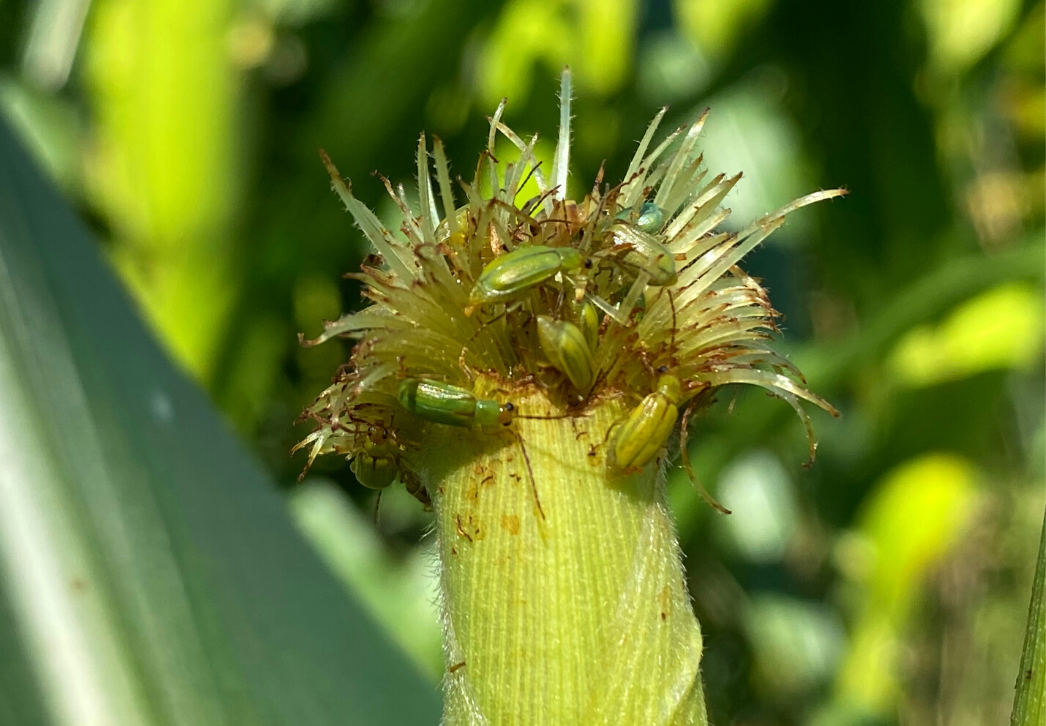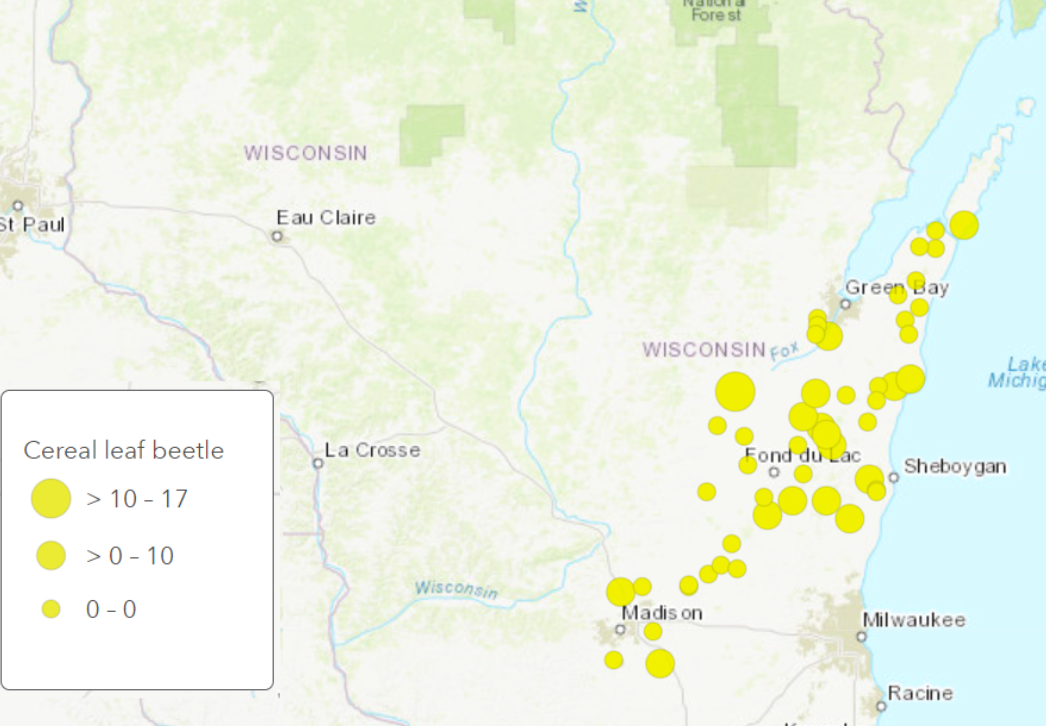|
|
An array of destructive weather and climate events threatened Wisconsin crop production during the 2023 growing season. In addition to historic drought conditions, growers experienced hazardous air quality from Canadian wildfire smoke, July storms that caused widespread crop damage, and a rare record-breaking early September heat wave. Although the areas of extreme (D3) and exceptional (D4) drought have largely resolved since late summer, abnormally dry (D0) to extreme (D3) drought conditions still prevail across 65% of the state going into the winter months.
As it has done since 1915, the Pest Survey Program at DATCP continued to monitor agricultural fields this season to collect data on the leading economic pests of concern to Wisconsin crop producers. Survey work was conducted from April through October and spanned across 62 of the state’s 72 counties. Besides assessing the abundance and distribution of Wisconsin’s most damaging crop pests, our field specialists also surveyed for several invasive priority pests that are currently not known to occur in the state, such as the soybean gall midge.
This end-of-season edition of Field Notes summarizes the results of our annual corn, soybeans, and small grains pest surveys. Another report featuring our forest, fruit, and vegetable pest survey results will be issued later this month. The information provided below is based on data collected by DATCP’s own field staff and by dedicated volunteers who report weekly counts to our insect trapping networks. This year, 80 cooperators participated in the Pest Survey Program’s monitoring networks. Our sincerest thank you to the agronomists, apple growers, farmers, crop consultants, gardeners, UW-Extension staff, vegetable growers, and others who contributed their time and expertise to support our efforts in 2023.
__________________________________
  Northern corn rootworm beetles | K. Hamilton DATCP
 
|
|
Corn rootworm beetle populations decreased across much of Wisconsin in 2023 following two consecutive years of high pressure. The annual survey in August found a state average of 0.5 beetle per plant, a drop from 0.9 per plant in 2022 and 0.8 per plant in 2021. The largest decrease in adult rootworm counts was recorded in the east-central region, where the district average fell from 1.1 beetles per plant in 2022 to 0.2 beetle per plant in 2023. Levels also dropped sharply in the southwest district, from 1.3 last year to 0.5 in 2023. Corn fields with populations above the economic threshold of 0.75 beetle per plant comprised 18% of this year’s 229 sites, compared to last year’s 33%.
In addition, the 2023 total count of 1,174 rootworm beetles was 40% lower than the 1,965 beetles tallied in 2022. Sixty-four percent (757 out of 1,174) of this season's beetles were northern corn rootworm, which has been the predominant species in the state for the last 10 years in a row.
Despite an overall decrease in Wisconsin beetle populations from the previous two seasons, areas of high rootworm pressure persisted in parts of the southern and western districts. Effective corn rootworm management in these higher-pressure regions will continue to require a multiyear plan emphasizing regular crop rotation (out of a continuous corn cropping system), selection of a dual or triple mode of action Bt-rootworm (RW) trait corn seed product and, in some situations, the use of a soil-applied insecticide at planting—usually for corn products without Bt-RW protection. Crop rotation remains the most effective regulator of corn rootworm populations by breaking the lifecycle and should be the foundation of integrated rootworm management. |
|
__________________________________ |
|
Moth counts documented during the June to mid-August flight period were the highest in 19 years of surveys. The 2023 trapping program registered an average of 223 moths per trap (9,351 moths in 42 traps), far surpassing the previous survey record of 133 moths per trap (4,804 moths in 36 traps) set in 2022. One-third of the sites recorded cumulative captures above 250 moths per trap, while the highest individual count for the 10-week monitoring period was 850 moths near Princeton in Green Lake County.
This season’s record-setting flight produced scattered heavy larval infestations in August and September in the central and western areas of the state with a history of higher western bean cutworm pressure. Fall surveys in field corn found full-grown larvae in ear tips at 18% of the sites visited, and in some cases, as many as 10-12 larvae per 25 corn ears sampled for caterpillars. |
|
__________________________________ |
|
Larval populations were extremely low again in 2023. The state average count in 229 corn fields sampled this fall was 0.02 borer per plant (or two borers per 100 corn stalks), which is a decrease from the 2022 survey average of 0.05 borer per plant and only slightly above the all-time low average of 0.01 per plant recorded in 2018 and 2019. Eight of the state’s agricultural districts showed averages less than or equal to last year’s levels, while a negligible increase was noted in the central area. Larvae were absent from 95% of the fields sampled in September and October.
The near-record low number of corn borers observed this year reflects the continued prevalence of Bt corn, which currently accounts for about 82% of the state’s corn acres. |
|
 __________________________________
|
|
Corn earworm trap counts were far higher this season at most monitoring locations, relative to the numbers collected in 2022. The 2023 monitoring program captured a total of 13,996 moths in 12 traps, with the largest flights recorded during the two weeks from August 24-September 7. Flights peaked at 244 moths per night near Beaver Dam in Dodge County, 149 moths per night at Pardeeville in Columbia County, 96 moths per night in Fond du Lac County, and 79 moths per night in Dane County during this timeframe.
Compared to 2022 when 4,173 moths were collected in 13 traps, this year’s total count was three times higher and corn earworm larvae were also more common during fall corn surveys. Corn earworm caterpillars were observed at 10% of corn sites checked in September and October. The pheromone trap location with this season’s highest cumulative catch was Beaver Dam in Dodge County, where 4,545 moths, or nearly one-third of the 2023 total moth catch, were collected. |
|
 __________________________________
|
|
Damaging, localized infestations of first-generation true armyworm larvae developed in southwestern Wisconsin in early June. Destructive feeding by armyworm caterpillars in corn fields, pastures, and in pasture-mix forages was observed during the week of June 8-14 in Grant, Iowa, Lafayette, and Vernon counties. A native plant nursery near Brodhead in Green County also reported that a 20-acre field of Virginia wild rye (Elymus virginicus) was completely defoliated by armyworms during the same week.
Pheromone trapping for true armyworm moths began in July, after damage by the first generation of armyworms had subsided. Captures of second- and third-flight moths in traps were very low. The true armyworm trapping network consisting of 14 traps in Dane, Grant, Green, Iowa, Lafayette, and Rock counties collected an eight-week cumulative total of 185 moths in July and August (average of 13 moths per trap), with the highest weekly counts recorded July 7-28. For perspective, Indiana’s network of eight true armyworm pheromone traps collected a cumulative total of 5,073 moths over the course of eight weeks (average of 634 moths per trap). Indiana’s single highest weekly catch was 414 moths per trap May 4-10, nearly four times higher than Wisconsin’s total seasonal catch.
Significant larval feeding was not observed after late June and only the first generation of armyworms was destructive this summer. |
|
 __________________________________
|
|
DATCP’s Pest Survey Program sampled 158 soybean fields in southern and western Wisconsin in 2023 as part of a multistate collaboration with the UW-Madison and the North Central Soybean Research Program to track the expanding distribution of the soybean gall midge (SGM). This new economic insect pest of soybeans has been found in 164 counties in six Midwestern states since 2018—Iowa, Kansas, Minnesota, Missouri, Nebraska, and South Dakota—including eight new counties this season. It is unknown whether SGM is native or invasive to the U.S.
Larvae of the SGM, a member of the Hessian fly family (Cecidomyiidae), feed internally in soybean stems and cause plants to become brittle and break at the base. Soybeans are susceptible to egg-laying by SGM flies as early as the V2 stage when plants begin to develop stem fissures or cracks. Severe yield reductions due to breakage and lodging are especially common at the field edge, with 100% yield losses from the edge up to 100 feet into the field.
Soybean gall midge has not yet been found in Wisconsin. The closest known infestations are in Rice County in south-central Minnesota, just 70 miles from western Wisconsin. In Iowa, SGM has been confirmed in nearly half of the 99 counties (48 total), including six central Iowa counties newly added in 2023. Based on its current proximity and available soybean acreage, it is anticipated that SGM will reach Wisconsin in the near future. |
|
 __________________________________
|
|
|
Soybean aphids | K. Hamilton DATCP
 
|
|
Populations recorded during the annual survey were extremely low. All of the 158 fields sampled from July 5-August 30 had average counts below 25 aphids per plant and no surveyed field showed above-threshold populations of 250 or more aphids per plant. The 2023 state average count was just three aphids per plant (30 per 100 plants), a decrease from the already very low average of six aphids per plant recorded in 2022. For comparison, the 2020 survey found an average of 15 aphids per plant and the all-time low average of five aphids per plant was recorded in 2019.
Results of this season’s effort suggest that aphid pressure was generally very low in 2023. It is unclear if the scarcity of aphids again this season was most influenced by environmental conditions and natural predation/parasitism, or due to widespread application of foliar insecticide and fungicide tank mixes applied in the early reproductive stages of soybean growth. Research clearly shows that preventative tank mixes of fungicide and insecticide are rarely cost-effective, except in instances where scouting confirms that insect levels are above-threshold. |
|
__________________________________ |
|
|
Surveys in wheat fields across the southern and east-central areas of the state in June found low insect counts, and very few foliar disease symptoms due to prevailing dry conditions.
During the two-week period from June 8-21, DATCP specialists sampled 50 fields in the following counties: Brown, Calumet, Dane, Dodge, Door, Fond du Lac, Kewaunee, Manitowoc, Sheboygan and Winnebago. These counties contain the majority of the wheat acreage in the state. In each field, sweep net samples for cereal leaf beetle, aphids, and true armyworm larvae were made at four sites (100 sweeps total per field). A sample consisting of 20 wheat heads and leaves was also collected for wheat blast testing at the DATCP Plant Industry Bureau Laboratory. Wheat blast (caused by the fungus Magnaporthe oryzae Triticum pathotype) was first reported in Brazil and has led to locally severe epidemics with up to 100% crop loss in affected fields in South America (Argentina, Bolivia, Brazil, Paraguay), Bangladesh, and Zambia.
The table and map below show the results of the pest sampling. English grain aphids were present at low to moderate levels in all but one of the fields, true armyworm larvae were found in low numbers in 28 of the fields, and cereal leaf beetle was collected from 17 of the fields. One exceptional Winnebago County site had a cereal leaf beetle count of 17 adult beetles per 100 sweeps and larvae were abundant on wheat foliage. The surveyor estimated 10% of plants in the field were showing defoliation and flag leaf feeding. Overall, insect counts were below economic levels and damage was not observed. All wheat samples tested negative for the wheat blast pathogen.
     
|
|
__________________________________ |
|
 https://content.govdelivery.com/accounts/WIDATCP/bulletins/3792091
|
|
|
|
|